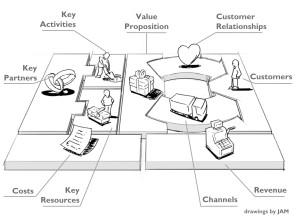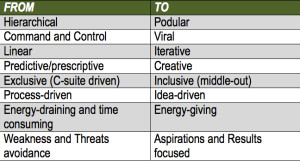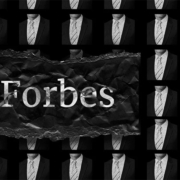Not your Father’s Business Model
When I first started out in strategic planning I knew it was my kind of work. I loved the creative aspects of charting new territories and going into daring new places. The events could be fantastic and inspirational, or draining and exhausting.
But they all had one thing in common: they seemed to never meet expectations (if not fail altogether). There was something missing between that great strategic planning process and the “actioning” processes that were intended to follow (but didn’t).
So what was missing?
First, the people ultimately capable of implementing the best ideas didn’t have a seat at the table. Strategy then was the domain of the C-Suite and Big 5 Consulting firms. And yet the best ideas and innovation rarely came from the top; in fact, they most often came from the farthest parts of an organization.
Second, we compromised values when they did not meet our quarterly objectives to be leaner and our drive to “do more with less.” When Jack Welch first said that the only responsibility of a corporation was to “enhance shareholder value” I guess most people thought that meant, “make a lot of money fast and get rich.” And they did. Sometimes. But we lost our hearts and souls in the process.
We forgot that sometimes it’s good business to do something that is worthwhile, despite the absence of double-digit growth objectives and ever increasing pressures for squeezing out margin. A lot of people were not happy and we lost entire segments of our economy due to “globalization” and cheap labor offshore.
But then things started to change. People started looking at the waste involved with shipping raw materials offshore only to ship the finished products back, not to mention the energy and passion lost when we focused on Return on Investment instead of the people that made things work.
Six years ago I attended my first Business Innovation Factory (BIF) summit in this far-away land called “Providence.” I saw a town not unlike the Seattle of the 1980’s- where the creative arts and innovative thought spoke through the lingering industrial recession of …something…new on the horizon.
Now I am hopeful.
 I heard people like Tony Hseih speak of “Return On Community” and investing in people …and the profits that follow. I Listened to Alex Osterwalder, Dan Roam, and Dave Grey as they tossed out all the traditional approaches and started designing business models that were crazy, purposeful, and passion-driven. I listened to Dan Pink remind us that people are really not motivated by money as much as they are excited about being relevant and making a difference.
I heard people like Tony Hseih speak of “Return On Community” and investing in people …and the profits that follow. I Listened to Alex Osterwalder, Dan Roam, and Dave Grey as they tossed out all the traditional approaches and started designing business models that were crazy, purposeful, and passion-driven. I listened to Dan Pink remind us that people are really not motivated by money as much as they are excited about being relevant and making a difference.
I see corporations and communities starting to make strides in energy, poverty, and environment where government stalls. I see education changing to excite and empower students to want to learn, instead of just teaching them to pass high-stakes standardized tests. I see communities embracing paths of self-reliance, transforming public services into career path partnerships and entrepreneurship, and graduates who aren’t just looking for jobs, but creating them – and with the support of growing ecosystems, like the SEEED summit for growing this global social enterprise movement.
This is not your father’s business model… and thank goodness, because if we want a different “what” we need a different “how”:
As for the strategic planning I mentioned earlier – talk about a whole new ball game. The SWOT analyses (Strengths, Weaknesses, Opportunities, Threats) I was taught in business school are being replaced with more solution-focused approaches, like SOAR (Strengths, Opportunities, Aspirations and Results). More significantly, the innovative C-suites are putting more seats at the table in planning discussions – many even opting for more tables in the room, inviting staff and stakeholder input to the strategy.
And it’s working. More than staying relevant and on top of their game, internal teams are gelling like never before, not just engaged but empowered to design more innovatively as they create and deliver value – for themselves and for the populations and communities they strive to serve.
This is not your father’s business model. Things are changing. And I am hopeful.










Leave a Reply
Want to join the discussion?Feel free to contribute!